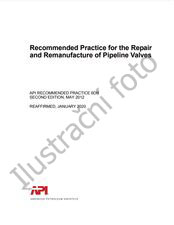Potřebujeme váš souhlas k využití jednotlivých dat, aby se vám mimo jiné mohly ukazovat informace týkající se vašich zájmů. Souhlas udělíte kliknutím na tlačítko „OK“.

API PUBL 4750-ed.1
Cyanide Discharges in the Petroleum Industry: Sources and Analysis
Přeložit název
NORMA vydána dne 1.11.2008
Informace o normě:
Označení normy: API PUBL 4750-ed.1
Datum vydání normy: 1.11.2008
Kód zboží: NS-1139887
Počet stran: 58
Přibližná hmotnost: 174 g (0.38 liber)
Země: Americká technická norma
Kategorie: Technické normy API
Anotace textu normy API PUBL 4750-ed.1 :
API PUBL 4750, 1st Edition, November 2008 - Cyanide Discharges in the Petroleum Industry: Sources and Analysis
Introduction
The American Petroleum Institutes (API) Clean Water Issues Task Force (CWITF) commissioned ths report to provide information and guidance to its members on the importance, presence, environmental fate, and analytical methods for cyanide compounds and related chemical species that may be found in petroleum industry wastewater effluents. A principle objective of this report is to provide technical information that will assist NPDES permittees in negotiating site-specific water quality-based effluent limits. The report also provides permittees with guidance on the sampling and analytical methods that must be used to assure that cyanide data are as reliable as practical, given the limitations of the analytical methods.
There are currently no national effluent limitations guidelines for cyanide and related chemicals that are applicable to petroleum industry discharges. However, the U.S. Environmental Protection Agency (EPA) has adopted water quality criteria for cyanide (EPA, 1985) under the authority of Section 304(a) of the Clean Water Act (CWA). All of the states and territories have used EPAs criteria, either directly or with modifications, to adopt water quality standards for cyanide under the authority of Section 303(c) of the CWA. Because the water quality standards for cyanide are uniformly very low, and because certain petroleum industry wastewaters contain cyanides, it is important for API member companies to have information resources that will: (1) assist them in participating in future regulation development by the states; (2) provide technical support for the development of NPDES permit limits, and (3) provide technical support for determining the levels of treatment required to achieve water quality-based effluent limits (WQBELs) that may be included in NPDES permits. Also, although this study did not identify in any states any stream segments impaired by cyanide, there is always the possibility that such a identification could occur and that a total maximum daily load (TMDL) evaluation for cyanide would then be required. The information in this report will be helpful in such cases, if they were to occur.
The chemical functional group cyanide (CN) is found on a number of inorganic and organic compounds. Chemicals containing CN have considerable environmental importance because when CN is present as free. cyanide (hydrocyanic acid (HCN) and the CN- anion), it is highly toxic to many life forms.
There are several other functional groups that contain the CN structure, but that generally are much less toxic than CN. These include the thiocyanate (SCN-) group, the cyanate group (OCN-), organic nitriles, and the selenocyanate group (SeCN-). Because these forms are found in certain petroleum wastes and as degradation products of free cyanide, they are also discussed in this section.



 Cookies
Cookies
